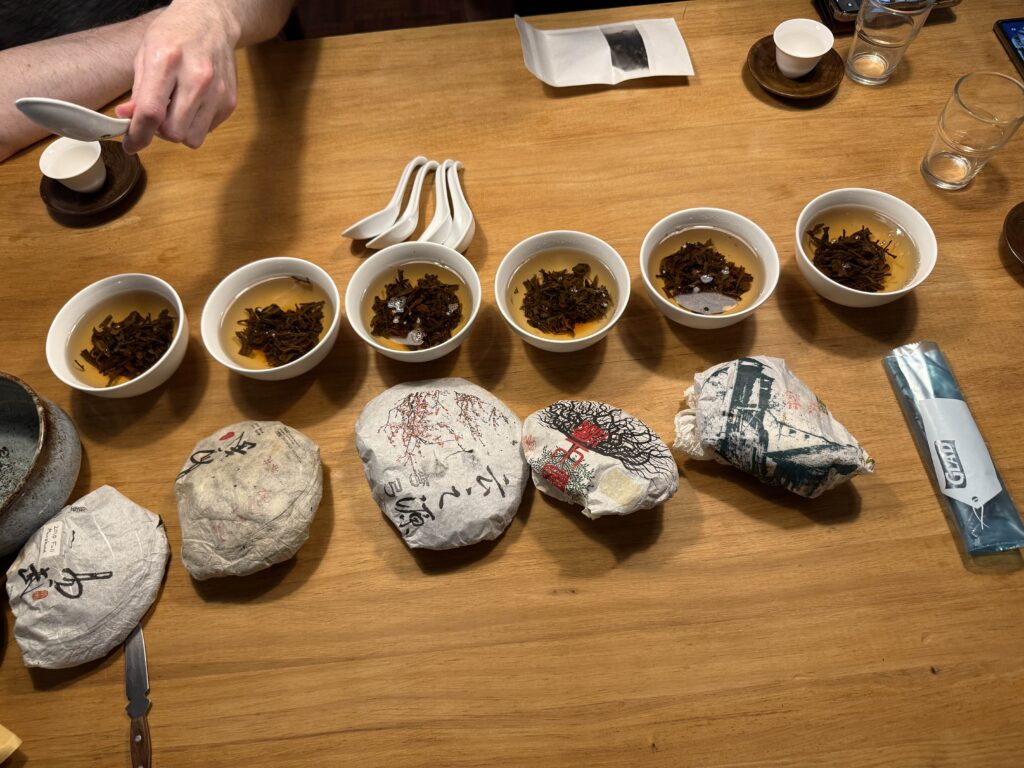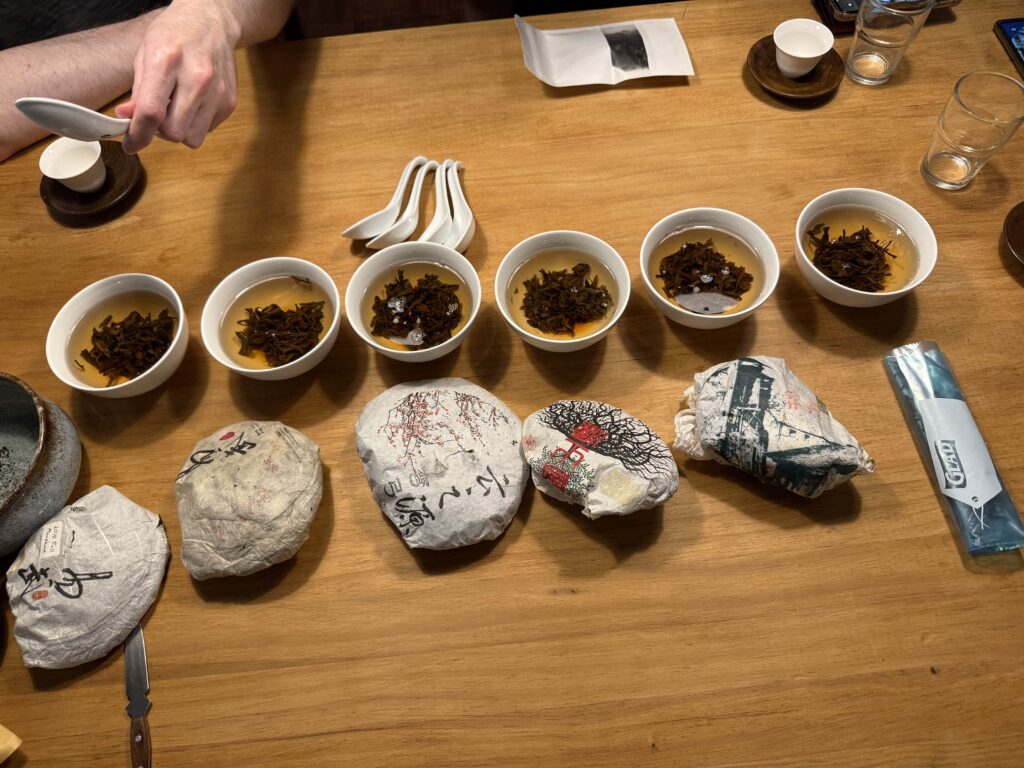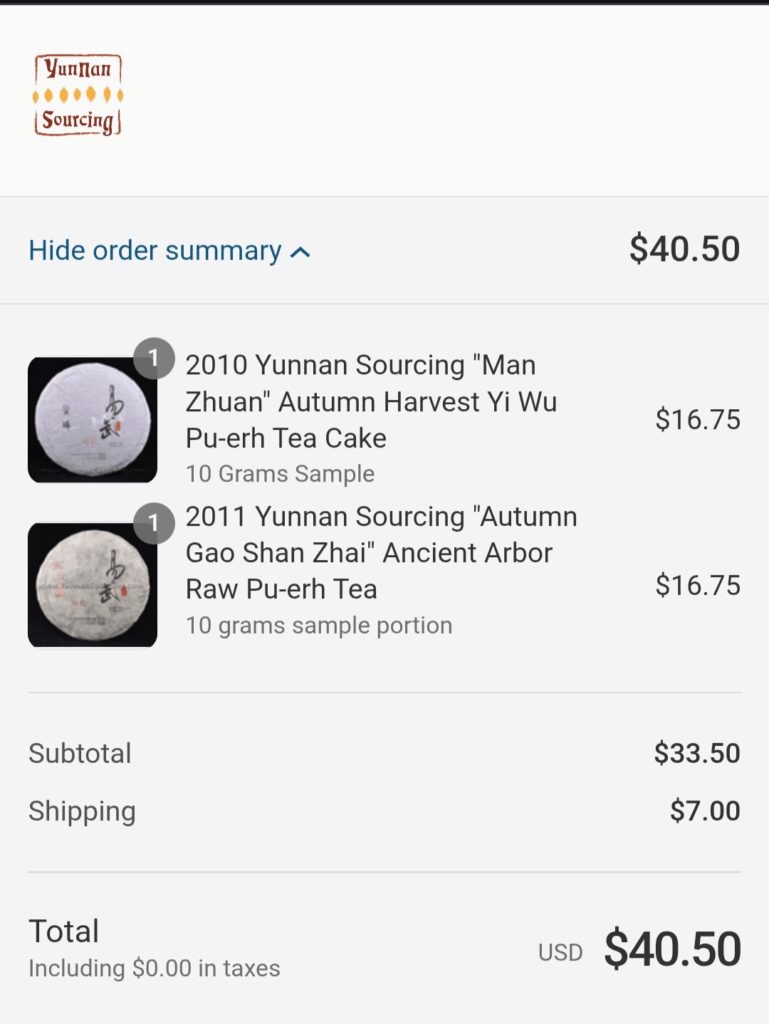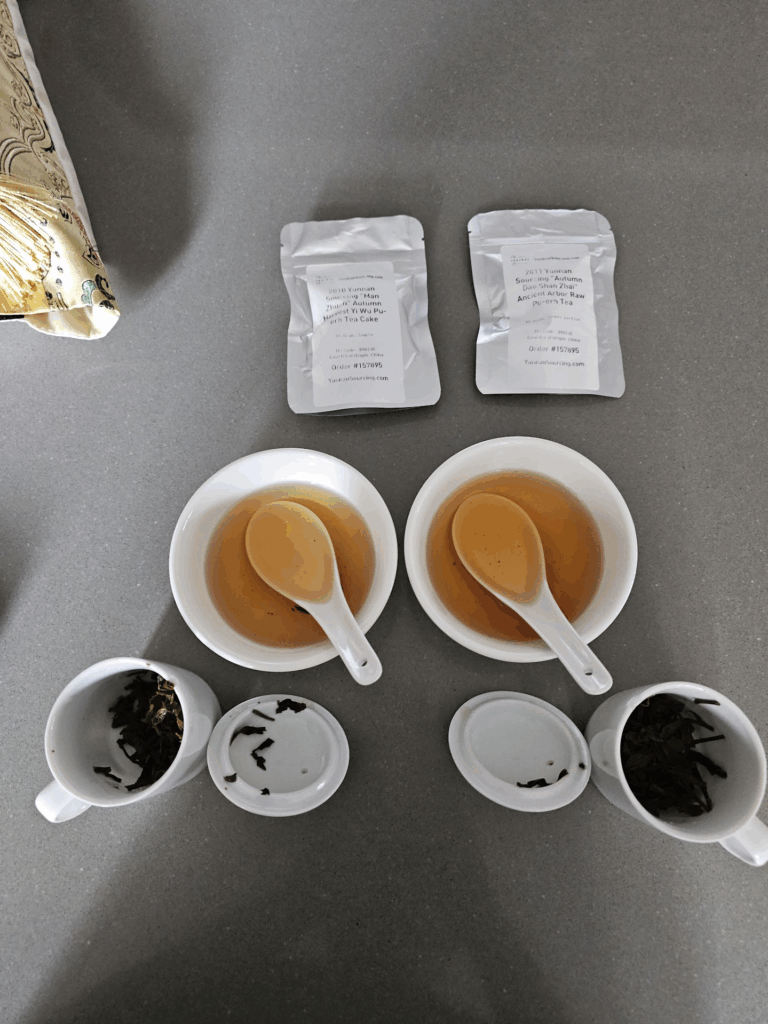Just about a dozen years ago I wrote a post about the dangers of green tea puerh. In short, young puerh that has been processed at too high a temperature that drinks well immediately but will age poorly. The same way if you drink old longjing it’s just…. bitter and gross. Well, a few weeks ago at a tea session with Alex of Taiwan Tea Odyssey we drank a tea that he has held for almost 14 years. It was a Yunnan Sourcing fall 2011 Yiwu Gaoshanzhai. The tea looked pretty ok – nice looking leaves, turning a bit yellow, but smells faintly of that old honeyed slightly aged puerh scent when dry. We brewed it gongfu. The first couple steeps seem ok – the tea has been aged in Los Angeles most of its life, only moving to Taiwan last year. We ascribed the issues with the tea – a bit of rough texture, weird flat notes and a bit of bitterness – to the LA storage. Then, we brewed it some more, and the nicer aspects of the tea – a cooling sensation, and some aged notes, started falling off, and the only thing remaining are stale green tea notes and a long lasting bitterness that doesn’t turn into sweetness.
Ok, here I thought we have a tea that is probably a mixture of green tea pu with some properly processed materials. The properly processed stuff was what made it taste ok in the initial steeps, but it gets overpowered by the bitter notes of aged green tea pu in the mixture. But, to be fair to the tea, we tried it again, this time in a lineup of bowl brews.


The lineup here is (left to right) 2010 Yunnan Sourcing Fall Manzhuan, 2011 YS Fall Gaoshanzhai, 2012 YS Fall Wangong, 2013 YS Spring Xiangming, a 2009 Spring Dianyi Mahei, and a 2012 Tea Urchin (RIP) Manzhuan. We used the same amount of tea and brewed with the same amount of water and just let it sit, which is a good way to evaluate a bunch of teas quickly while being able to compare them side to side. Try it sometime.
The first five teas all came from Alex’s storage, and were acquired around 2012/2013. The Tea Urchin tea was stored in Singapore almost this entire time. Of these teas, unfortunately our early friend the Gaoshanzhai was probably the worst of the bunch – the bitterness is the most obvious here, plus the poor mouthfeel. The other two fall teas also didn’t fare very well, but are a bit more faded but less bitter, to the point where they’re a bit bland at this point. The spring Xiangming was, I believe, cheaper when bought, and it showed. The Dianyi Mahei is ok, but not great for something that is now 16 years old. Finally, the Tea Urchin tea. It’s the best of the bunch – no weird bitterness that lingers, for one. It’s aging all right. But nobody can buy it anymore since the store is dead, so that’s that.
Now, dear reader, you might be thinking – Los Angeles is a horrible place to store tea! It’s not a surprise the Singapore stored tea is the best! Yes, I know. It’s dry, hot, and just not very good for aging puerh. Those of you who live there, go buy oolongs.
But I digress. To make sure that it isn’t Alex’s bad storage talking, I decided to do a public service and spend forty American bucks to buy two samples fresh from Yunnan Sourcing to make sure it’s not the City of Angels that’s causing problems for the teas.

After their arrival, I tried them.

Unfortunately I must report that Kunming or whatever storage Scott has for his teas are no better. I mean, we always know that Kunming storage isn’t the best, but in order to eliminate the possibility of Alex’s storage doing bad things to the tea, I had to find another source for it to make sure that’s the case, and there’s no better way to do it than to buy it from the source. After all, you can still buy whole cakes of these things from Yunnan Sourcing. I used 3g for 5 minutes brews. The Manzhuan, it turns out, is just very, very bland. It’s a bit rough, a bit bitter, but mostly just rather bland and hollow. The Gaoshanzhai is clearly made of better material – throat cooling, a bit of body, it has signs of good base material, but it also has the same problems as Alex’s sample – rough, very bitter, not much fragrance.
For an almost 15 years old tea, this is not good. It’s not going to get better at this point. It is quite clearly at least contaminated by at least some measure of green tea processed puerh in here. If you have cakes of this, I would be curious to hear your reports of how they taste now. I myself am wondering if a few cakes I bought from them around then are doing similar things – I haven’t tried them since I bought them. But if it’s at all similar to how these batches are turning out, things are not promising.
There were some questions in the dozen year old post about how to notice these issues – green tea processing most often shows up as teas that have a sort of green bean fragrance. It’s sweet and soft, with a beany taste. That bean taste is a product of a higher temperature shaqing that turns the tea into green tea – which also stops any prospect of future aging. If you’ve had stale green teas that are a few years old, you’d know how that tastes. It’s dry, rough, grassy in a bad way, and bitter. I haven’t bought that much new teas in the past ten years, so I have little idea how prevalent this issue still is at this point. However, if your puerh is getting more bitter over time, it’s a bad direction to go in.

 RSS - Posts
RSS - Posts
I took you at your suggestion and have been reading some of your old post-Covid posts. I haven’t been to…